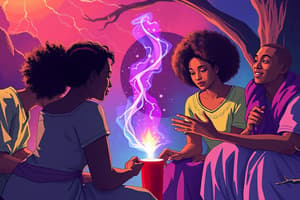Podcast
Questions and Answers
Match the following theorists with their contributions to defining group social work:
Match the following theorists with their contributions to defining group social work:
Kurt Lewin = Developed field theory, emphasizing the dynamic interaction between individuals and their environment. Grace Coyle = Defined group work as an educational process and emphasized social responsibility and democratic participation. Gisela Konopka = Focused on the therapeutic aspects of group work and the importance of building relationships in a group setting. Helen Harris Perlman = Emphasized the problem-solving approach and the person-in-environment perspective in social work.
Match the following types of groups with their primary purpose:
Match the following types of groups with their primary purpose:
Education Group = To enhance members' knowledge and skills. Therapy Group = To aid members in resolving emotional and psychological problems. Task Group = To complete a specific task or achieve a defined goal. Support Group = To provide emotional support and understanding among members sharing similar experiences.
Match phases of group development with typical activities:
Match phases of group development with typical activities:
Initial Phase = Orientation and formation of group norms. Transition Phase = Conflict and resistance to group influence. Working Phase = Collaboration on the task and achievement of goals. Termination Phase = Review of group experience and planning for future activities.
Match the following member roles with their descriptions:
Match the following member roles with their descriptions:
Match the following communication patterns with their characteristics:
Match the following communication patterns with their characteristics:
Match the following basic skills for Group Workers with their descriptions:
Match the following basic skills for Group Workers with their descriptions:
Match the following factors with their impact on group influence::
Match the following factors with their impact on group influence::
Match the following methods of resolving group conflict with their descriptions:
Match the following methods of resolving group conflict with their descriptions:
Match the characteristics relating to types of Communication:
Match the characteristics relating to types of Communication:
Match information relating group communication problems to a solution:
Match information relating group communication problems to a solution:
Match different types of factors that can influence relationships in a closed setting:
Match different types of factors that can influence relationships in a closed setting:
Match the examples to reasons group terminations and their causes:
Match the examples to reasons group terminations and their causes:
Match each type of leadership style and its associated trait:
Match each type of leadership style and its associated trait:
Match terminologies involved in Groups and Team:
Match terminologies involved in Groups and Team:
Match the steps to an effect and the end goal to effective groups:
Match the steps to an effect and the end goal to effective groups:
Match different characteristics on why individual role is important:
Match different characteristics on why individual role is important:
Match each one of member attribute involved in cohesion:
Match each one of member attribute involved in cohesion:
Match each type of environment that'd involve a good method:
Match each type of environment that'd involve a good method:
Match the definitions on the stage of Group Interaction:
Match the definitions on the stage of Group Interaction:
Match each type of social networking style for a group:
Match each type of social networking style for a group:
Match each problem in a group and their response:
Match each problem in a group and their response:
Match which one of social interaction can be effective to change:
Match which one of social interaction can be effective to change:
Match these to the conclusion causes of a discussion:
Match these to the conclusion causes of a discussion:
Match the types of leadership traits within a group setting:
Match the types of leadership traits within a group setting:
Match those traits with groups and teams:
Match those traits with groups and teams:
Match each one of those points with the right term for cohesive relationships:
Match each one of those points with the right term for cohesive relationships:
Match locations of meetings to why those location matter for group development:
Match locations of meetings to why those location matter for group development:
Match the basic steps of a typical team interaction:
Match the basic steps of a typical team interaction:
Match each factor to helping and affecting each communication measure:
Match each factor to helping and affecting each communication measure:
Match the main solution:
Match the main solution:
Match the social interaction:
Match the social interaction:
Match what helps you:
Match what helps you:
Match types here:
Match types here:
Flashcards
What is group work?
What is group work?
A comprehensive definition of group work.
What are educational groups?
What are educational groups?
Groups formed to achieve behavioral changes and social learning objectives.
When did group work start?
When did group work start?
A method of social service that began in 1844 with the establishment of the Young Men's Christian Association in England.
What is Group Process Theory?
What is Group Process Theory?
Signup and view all the flashcards
What are mixed-gender groups?
What are mixed-gender groups?
Signup and view all the flashcards
What is mutual relation?
What is mutual relation?
Signup and view all the flashcards
What is Unresponsive Style communication?
What is Unresponsive Style communication?
Signup and view all the flashcards
What are task roles?
What are task roles?
Signup and view all the flashcards
What are Procedure Norms?
What are Procedure Norms?
Signup and view all the flashcards
What is group decision-making?
What is group decision-making?
Signup and view all the flashcards
What is the worker's role in group work?
What is the worker's role in group work?
Signup and view all the flashcards
Therapeutic group work?
Therapeutic group work?
Signup and view all the flashcards
Group worker's attitude?
Group worker's attitude?
Signup and view all the flashcards
Resolving group conflict?
Resolving group conflict?
Signup and view all the flashcards
Group communications?
Group communications?
Signup and view all the flashcards
Communication barriers?
Communication barriers?
Signup and view all the flashcards
Group work records?
Group work records?
Signup and view all the flashcards
Group leader functions?
Group leader functions?
Signup and view all the flashcards
Small meeting decision making?
Small meeting decision making?
Signup and view all the flashcards
Indirect technique?
Indirect technique?
Signup and view all the flashcards
What is a natural group?
What is a natural group?
Signup and view all the flashcards
What is a Mixed-sexuality group?
What is a Mixed-sexuality group?
Signup and view all the flashcards
What is group cohesion?
What is group cohesion?
Signup and view all the flashcards
What is is Sustained Group?
What is is Sustained Group?
Signup and view all the flashcards
What is Role Expectations?
What is Role Expectations?
Signup and view all the flashcards
Study Notes
- Comprehensive definition of group social work is achieved after compiling numerous opinions.
Group Types
- Behavior change and social learning groups are education groups.
- Educational groups aim to change behavior and promote social learning.
- Educational groups also prioritize the transfer of knowledge and skills.
Historical Context of Group Social Work
- Group social work emerged as a social service method in 1844 when the YMCA was founded in England.
Key Theories for Group Social Work
- Field theory emphasizes group change.
- The dynamic process is key to field theroy.
Gender Considerations
- Single-gender groups are unsuitable for therapy groups.
Interpersonal Relationships
- "One willing to hit, one willing to be beaten" describes a sadistic relationship.
Effective Communication
- Communication pattern where only leaders send signals without active member response is referred to as unresponsiveness.
Group Roles: Task-Oriented
- Initiators and coordinators fall under this category.
Group Norms
- Cultural norms develop gradually.
- Cultural norms evolve slowly over time.
Group Decision-Making
- Key decisions should consider forming consensus.
Core Objectives in Initial stages of Group
- Establish interpersonal relationships
- Define group norms
- Determine group goals
- Select members.
Three Models of Social Work
- Three Models of Social Work include social goals and interactions.
Treatment Model
- Three Models of Social Work includes individual prevention and rehabilitation.
Essential Attitudes of A worker
- Empathy
- Sincerity
- Respect
Conflict Resolution
- Avoid escalating win-lose scenarios
- Utilize group strengths to handle conflicts
- Focus on creating standards and basic rules.
Group Communication
- Group communication involves not only information exchange, but also interpersonal connection.
Barriers to Communication
- Leakage and misinterpretation are types of barriers to information exchange
Record-Keeping
- Recording group sessions and writing meeting minutes are key documentation skills.
Effective Leadership
- Facilitation of group member relationships helps create unity.
Decision-Making Formats
- Roundtable discussions are suitable for small decision-led groups
Studying That Suits You
Use AI to generate personalized quizzes and flashcards to suit your learning preferences.
Related Documents
Description
Explore group social work, including behavior change and social learning groups. Delve into its historical context, tracing back to the YMCA's founding in 1844. Understand key theories like field theory, communication patterns, and interpersonal relationships.




